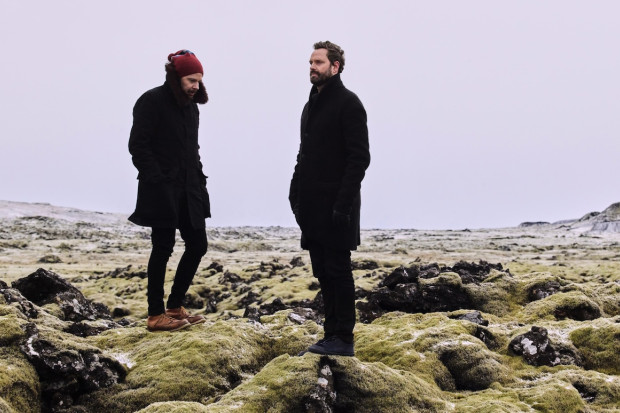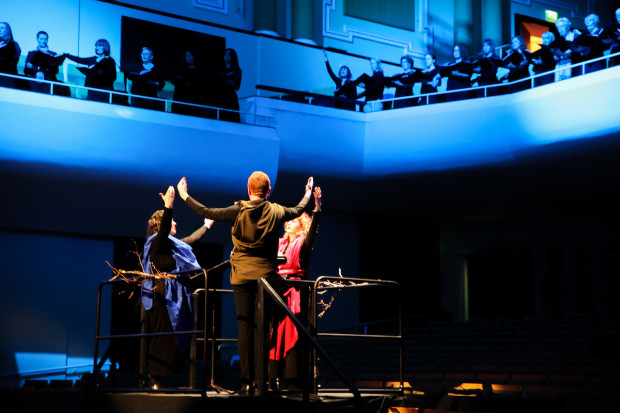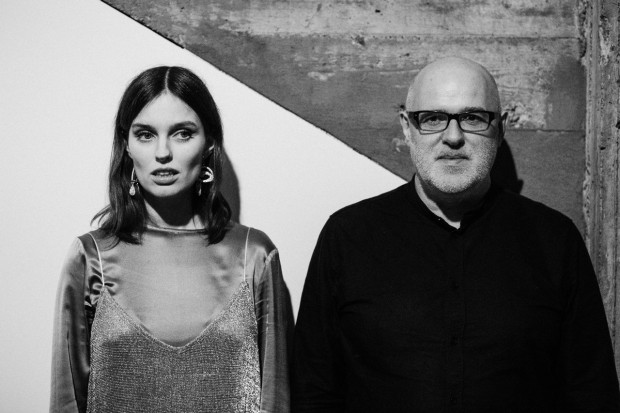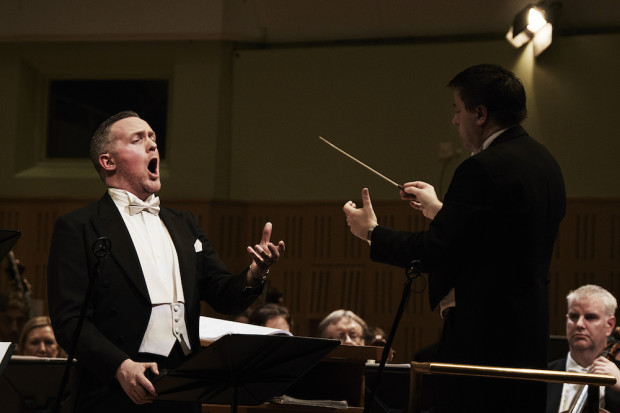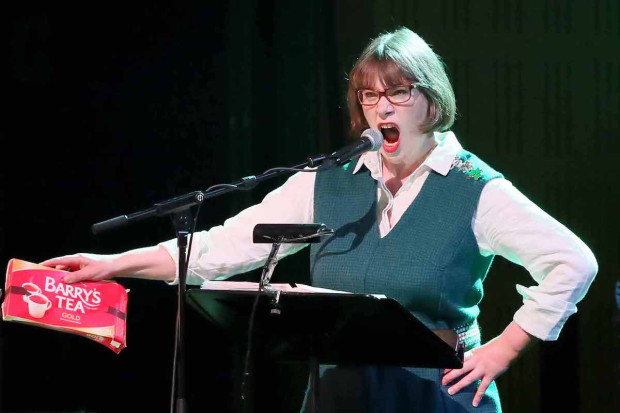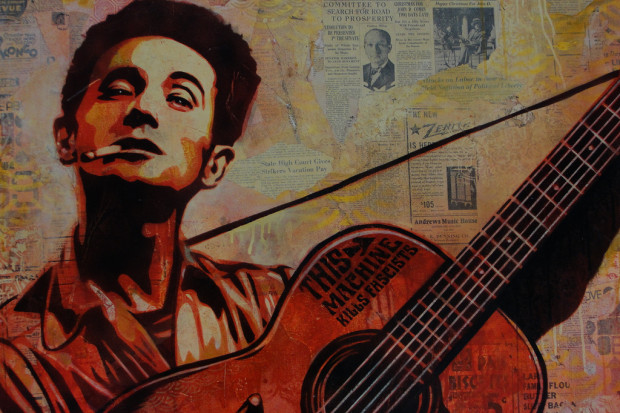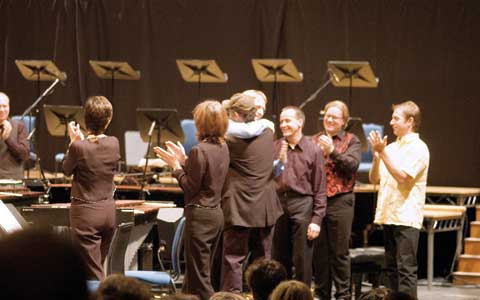
Steve Reich with Ensemble Modern in Dublin, 2006.
A Few Days in the Sun?
I was at the very heart of the city. The postal code of my office was ‘Dublin 1’. From my office window, I could eventually glimpse the Spire of Dublin, the 120-metre, shimmering, pin-like monument that I watched being erected in 2003. The site of the Spire was traditionally regarded as the exact centre of Dublin City.
This city was itself at the core of a country that had only recently overcome its historic poverty. Working by day in a book publisher, I wandered the streets at lunchtime, usually from bookshop to bookshop, and witnessed the ramping up of the economy: bank queues, energetic shopping, ubiquitous takeaway coffees, new apartment blocks and shops, street sculptures and adventurous bridges, contemporary street lighting, large crowds at traffic lights, people out-of-it on heroin on the main thoroughfare, endless advertisements for musical and artistic events.
It was almost too much to take in. Not able to take full advantage of the endless cultural fare – we had two small children and lived in the suburbs – I comforted myself with my traditional pastime of lunchtime and early evening contemporary music concerts, saving myself up for big events.
My reaction to the new Irish music of the time was what I most remember about those early years of the 2000s – Roger Doyle’s Passades, Donnacha Dennehy’s To Herbert Brün, Jennifer Walshe’s dirty white fields, Raymond Deane’s slightly earlier Seachanges, and works by Benjamin Dwyer, Ian Wilson, Gerald Barry, Ronan Guilfoyle and Andrew Hamilton. I sensed my responses were tied into the times we were living in, its pressures and contradictions. These concerts could be combative, clarifying, abrasive or still – the music literally forcing something from the room. I sank into these adventures, clinging to their craft, breathing in their audacity and immoveability. As the last note of each concert was held and echoed, I felt that it was literally holding the door shut against the forces outside.
Outside, public debate was thin, a conversation of convenience that refused to connect the dots of our society, to balance growth with needs and fairness. The logic of economic growth at any cost was overwhelming us all. In the years since, I have resisted over-analysing the music of that period, but time cannot help but offer clarity.
Raymond Deane pointed to the tangential status of Irish contemporary music during the Celtic Tiger boom, when he wrote in this magazine in February 2002 that Irish composers ‘deliberately impede’ the state’s influence. What these new-music concerts offered were sites of resistance. It was a space one could occupy that was not persuaded by the economic logic.
As the new-music scene in Ireland grew during the 2000s, it began to move, surprisingly, given its uncompromising nature, from the periphery towards the centre. Permanent emigration had ceased, a new generation of ambitious musicians and composers were making their presence felt, and this was coupled with an unprecedented level of arts funding. As Roger Doyle noted at the time, for years his generation of composers (those born c. 1950, and who generated a blossoming of new music in the 1970s) had been looking over their shoulder waiting for the next generation to come along. Suddenly, in the 2000s, it was like being surrounded by ‘locusts’. In an article in The Journal of Music in Ireland in January 2004, the composer Benjamin Dwyer captured the new environment:
The last twenty years has seen the development of festivals and events such as the Sligo Contemporary Music Festival, the Ennis School of Composition, the RTÉ Living Music Festival, the Sonorities festival, the Composers’ Choice series at the National Concert Hall, the Mostly Modern series at the Bank of Ireland Arts Centre, Opera Theatre Company (for new Irish opera), the National Symphony Orchestra’s Horizons series, the Hugh Lane Gallery’s Sundays at Noon series, not to mention the emergence of the new music ensembles Concorde, Vox21, Crash, Whispering Gallery and Double Adaptor. And this is merely a swift perusal. The face of Irish art music has altered radically … and the social implications of this have been so extraordinary and far-reaching that it would not be an exaggeration to describe these developments as a new renaissance.
Between 1998 and 2008, the Arts Council budget grew from thirty-five to eighty-two million, which not only fed into music in the form of direct funding to artists, but also grew the constellation of resources and events that had been gradually building up. In 1985, the Contemporary Music Centre was established, followed in 1986 by Music Network (which organised concerts throughout the country), the Irish Traditional Music Archive arrived in 1987, the Improvised Music Company in 1991, the Sligo Contemporary Music Festival in 1997, the Crash Ensemble – a groundbreaking new-music ensemble – in 1998, Note Productions, Waterford New Music Week, Sonorities Festival, and the Forum for Music in Ireland – an umbrella group and campaigning body – in 1999, The Journal of Music in Ireland in 2000, the first RTÉ Living Music Festival – a major new state-sponsored contemporary music festival – and the Dublin Electronic Arts Festival (DEAF) in 2002, the i-and-e group organising improvised music events in 2003, the Young Composers’ Collective in 2004 (later the Irish Composers’ Collective), Ireland Promoting New Music set up by composer Siobhan Cleary in 2005, and the Louth Contemporary Music Society and the production company Ergodos in 2006.
When this magazine began in 2000, it could quite comfortably keep up with the number of new-music events in the country. By 2006, that had become almost impossible. New-music festivals, once annual events, now clashed regularly in the calendar. And they didn’t restrain themselves to traditional forms: pop, rock, multimedia, electronics and improvisation all become normal features of the output of Irish composers.
A high watermark arrived with the fourth RTÉ Living Music Festival in 2006. Featuring the music of Steve Reich, with the composer in attendance, it drew a large, young and diverse crowd. It was widely seen as the apex of growth up to that point, drawing on all the energy and vibrancy of the entire scene. In a sense, it signalled the full arrival of a new generation.
In order to get there, however, a generation had had to reconcile itself with the logic of the Celtic Tiger economy, to begin to see it not as something that should be resisted, but rather as a development that could yield great opportunities. That conclusion, of course, is precisely what the full implementation of this economic logic needed to achieve.
The final concert of that RTÉ Living Music Festival was a performance of Music for 18 Musicians, a masterpiece written in the mid-70s and which was about as old, or older than, many of the people in attendance. As written in this magazine shortly afterwards by the young composer Jürgen Simpson, ‘To hear it being played in the National Concert Hall with the composer present must surely rank as one of the finest musical moments that venue has ever seen.’ There is a sense now, however, that with a generation’s success within the terms of reference of the Celtic Tiger, came also a cessation of any resistance to the logic of economic growth at all costs. As this logic was embraced by more and more citizens, borrowing and spending reached unprecedented levels. In 2006 and 2007, the system was pushed to breaking point. In late 2008, it collapsed.
The results of our embrace are now clear to see. The RTÉ Living Music Festival was suspended in 2009, as was regional touring by the RTÉ National Symphony Orchestra; Arts Council funding has been cut for the last two years and the music budget has been reduced by almost 20%; the first new-music ensemble Concorde (founded in 1976), as well as the Association of Irish Composers, and Music 21 (formerly Mostly Modern) were refused all funding this year; Crash Ensemble’s funding was reduced by 13.5%; Note Productions were cut by over 60%, and the Louth Contemporary Music Society by over 53%; the DEAF festival, unable to secure regular funding or sponsorship, finished up last year; the Improvised Music Company and the Contemporary Music Centre received decreases of over 22%; and the long-running Sundays at Noon/Gallery Music series was cut by over 43%. Progress built up over years has now been snuffed out or damaged by an overarching financial and cultural short-termism.
Is a few days in the sun what it was all about? Is the fate of the Irish music scene to simply accept the logic of economic growth and soon march up the hill again, only to fall back down a couple of years later? Or is it going to use the experience, self-reliance and determination that it learned from the Celtic Tiger to challenge its logic and agitate for a music scene – and an economic environment – that is truly sustainable? There are still new initiatives cropping up – the monthly Kaleidoscope events in Dublin, for example – but in the economic challenges that it now faces, we are about to find out what this generation is really made of.
Published on 1 April 2010
Toner Quinn is Editor of the Journal of Music. His new book, What Ireland Can Teach the World About Music, is available here. Toner will be giving a lecture exploring some of the ideas in the book on Saturday 11 May 2024 at 3pm at Farmleigh House in Dublin. For booking, visit https://bit.ly/3x2yCL8.










